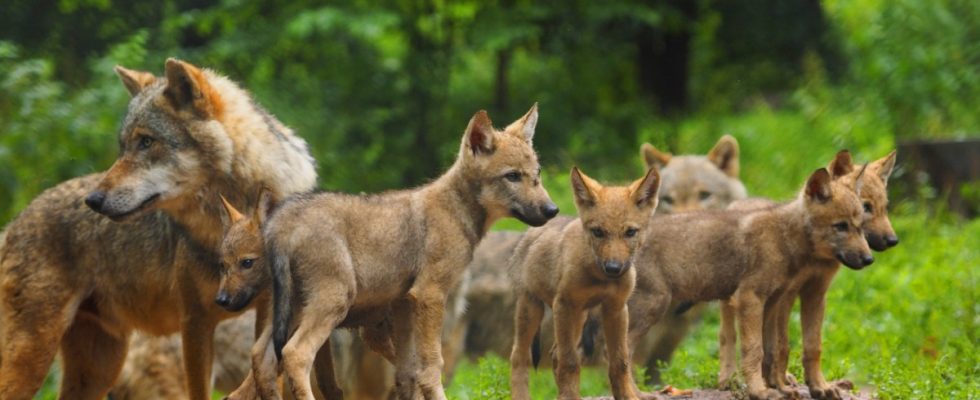It’s been a good three years since a young she-wolf from the Veldensteiner Forst settled in the Altmühltal near Eichstätt. From this point at the latest, it was clear that the many sheep farmers in the region should protect their animals from possible attacks, especially if they leave them outside at night. In autumn 2022, a male wolf from Brandenburg was found in the Altmühltal. The female and he soon found each other. Experts therefore assumed that a pack would very likely establish itself there in spring 2023. You were right: at the beginning of July, seven wolf pups ran into a camera trap in Altmühltal. There are currently nine wolves in the region.
At the same time, it turns out that apparently only a few livestock keepers in the Altmühltal have taken precautions. For a few days now, livestock tears have been increasing in the Eichstätt and Neuburg-Schrobenhausen districts. “It feels like the wolf strikes somewhere here every other day,” says sheep farmer René Gomringer, who keeps a herd of around 30 animals near Beilngries. At the State Office for the Environment (LfU), which is responsible for wolf monitoring in Bavaria, they currently have three suspected cases. This means that the genetic evidence is still pending, but otherwise everything points to a wolf attack.
The first happened a week and a half ago in a fallow deer enclosure. An adult animal and a calf fell victim to him, and four fallow deer have been lost since the attack. The following night a flock of sheep was attacked in a pasture. Four sheep were dead, two have disappeared. The third attack involving a dead sheep occurred earlier this week between the Irgertsheim district of Ingolstadt and the town of Bergheim (Neuburg-Schrobenhausen district).
As different as the attacks and as great as the suffering for the owners of the animals may be, they have one thing in common: neither the fallow deer nor the two flocks of sheep were protected against wolf attacks. The LfU and the State Association for the Protection of Birds (LBV) have now pointed this out. And the Office for Food, Agriculture and Forestry (AELF) in Ingolstadt-Pfaffenhofen ad Ilm has it Süddeutsche Zeitung confirmed. “Wherever we have promoted appropriate herd protection, nothing has happened so far,” said the responsible employee.
It’s bitter, but it’s obviously the case: “Many of us scold the wolf, but they don’t do anything to protect their animals,” says sheep farmer Gomringer. The agricultural engineer should know. For many years he was the managing director of the Bavarian sheep farmers’ association and for that reason alone he was intensively involved with the return of wolves to Bavaria. In his retirement he is now involved as a consultant in matters of livestock protection.
The Free State finances the construction of fences
According to Gomringer, it cannot be due to a lack of knowledge. “If there is a lecture or an information event, then they are well attended,” he says. “Up to 300 people come.” The district office and other authorities would have informed the livestock owners again and again. The LBV man Andreas von Lindeiner reminds that the AELF Ingolstadt-Pfaffenhofen had already written in August 2021 to its information offers on the subject of wolves. “But by no means all pet owners have accepted these offers,” says Lindeiner. “So it had to come to attacks.”
The authorities do not just leave it at information. Instead, the Free State also pays lavish grants to shepherds and other livestock farmers who want to protect their livestock effectively from wolves. The investment costs for wolf-deterring fences are even covered in full. “And even if a sheep farmer with his pastures is outside the development area, he can upgrade his existing electrical networks with little money,” says Gomringer. This is only a little more difficult with game animals.
The question remains why the livestock owners in the Altmühtal do so little to protect their animals? “They rely on the wolves being shot down at some point,” says Gomringer. That’s not going to happen, at least not anytime soon. Because the specifications of the new Bavarian wolf ordinance, which is intended to facilitate such killings, expressly do not apply to the Altmühltal and many other regions in Bavaria.
On the one hand, there has been no immediate danger to people from the attacks, at least so far. The Eichstätt District Administrator Alexander Anetsberger (CSU) explained this in BR at the beginning of August. But such is the top criterion for a wolf kill. The same applies to the second criterion. According to this, the attacks must take place in a non-protectable grazing area. So far, many pastures and alps in the Upper Bavarian and Allgäu mountains have been classified as such, where the mountain pastures are often so steep that, according to the state government, they cannot be fenced off. The specification does not apply to the rest of Bavaria and thus the Altmühltal.
Although there is little chance that wolves from the Eichstätt pack can be shot down quickly and legally, there are always politicians who nurture the hope of animal owners that the so-called removals will be made easier. The Secretary of State for Economic Affairs and former Neuburg-Schrobenhausen District Administrator Roland Weigert (free voters), who is also a passionate hunter, just recently pleaded in a local newspaper for the strictly protected animals to be included in the hunting law and for professional management.

